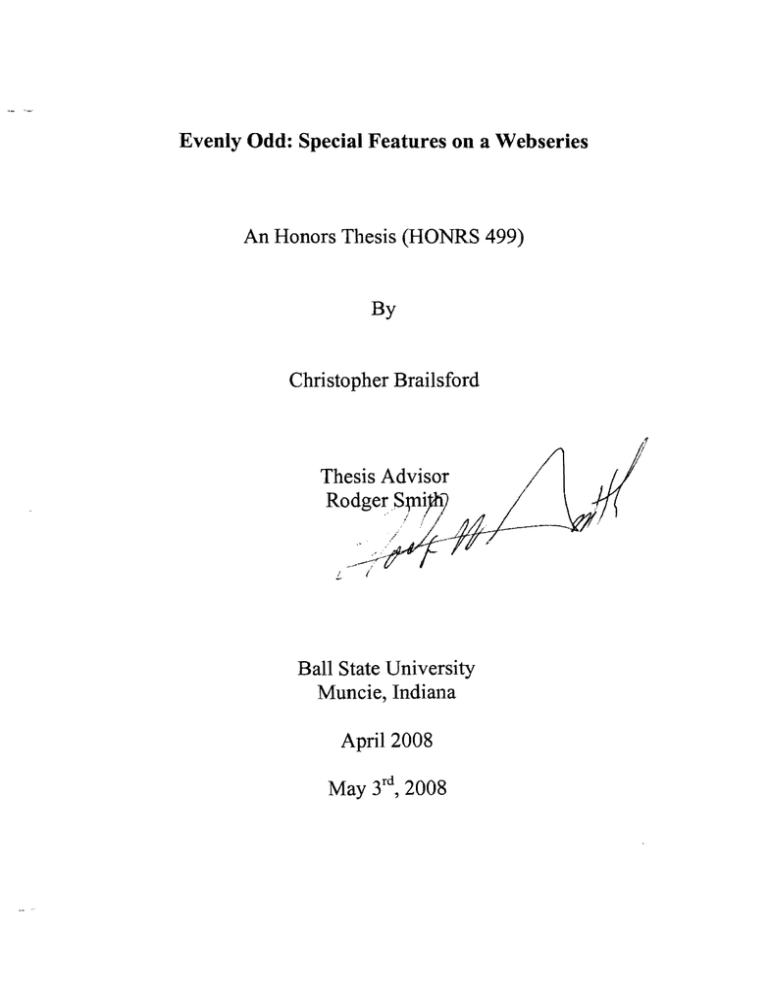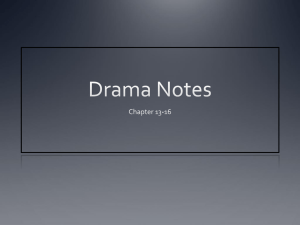Evenly Odd: Special Features on a Webseries By Christopher Brailsford
advertisement

Evenly Odd: Special Features on a Webseries An Honors Thesis (HONRS 499) By Christopher Brailsford Ball State University Muncie, Indiana April 2008 May 3rd, 2008 Abstract In this age of internet provided content, the Institute of Digital Education and Entertainment, in collaboration with the College of Fine Arts, the Miller College of Business, and the Center for Media Design, seeks to market to the college-aged individual through a web series titled "Evenly Odd". The series, the script of which was written by Ball State student Mo Hammond, is a showcase of student talent in all areas of production. Students filmed, acted, edited, lit, and marketed the series. To help assist in the marketing I headed up the Special Features team, which provided content to coincide with the actual production, along with furnishing the audience a "behind the scenes" perspective of the tasks required to develop such an enormous undertaking. Our goal is to relate to a college audience and entertain them, and I have provided several videos and photographs which display our efforts. Evenly Odd For my thesis project, I chose to provide special feature assets to the developing web series, Evenly Odd. This project was undertaken through collaboration with the College of Fine Arts, the Miller College of Business, the Center For Media Design, and the Institute for Digital Education and Entertainment. For my part in this project, I undertook developing several segments with the special features team, which included Donn Stories, Street Teams, and interviews with the cast. In addition, I also provided still images for behind the scenes elements. All of the features are to be included on the series website in the Fall of 2008. In tenns of deciding what we as the special features team should do, we had to negotiate with the marketing team, as well as provide a detennined amount of assets to be placed on the website. At the beginning, we had a meeting with all areas of the production and set forth a list of possible videos to create. These included blooper reels, fake trailers, web-cam confessionals, interviews, and still photographs. As time went on, it became apparent that we had set lofty goals for ourselves, and needed to scale back our efforts. From that moment on, we had to scrap approximately half of our original content, and focus more on the material that we could reasonably get. When the cast had a free moment, we took them aside and interviewed each person in tenns of their character, based on the idea that each person was unique and brought something different to their roles. I wanted the audience to get a sense of who the actual person was portraying the character they see on screen, how they relate (or do not) to that character, and what they enjoyed about being involved in such an immersive project. Due to scheduling complications with the cast outside of shooting, my team and I faced a difficult time attempting to gather them together for separate elements. We also realized that the production crew faced an enormous strain under lack of time to shoot everything and edit it for release. With that in mind, blooper material seemed to be nearly non-existent, and shooting "alternate scenes" was not possible. So, we had to decide what we as a team could accomplish that would tie in to the overall product, but not take away the time the production side needed with the cast. Keeping that in mind, my team and I decided to showcase real college students and their experiences living in a dorm setting. From this, we created the segment titled "Dorm Stories", which we filmed in the Letterman Building using a green screen to matte out the area behind our seated students. We invited anyone passing by to participate, as well as posted signs throughout several buildings to increase our numbers. We asked them to share a prank they or someone else they knew was involved in, or any other type of "interesting" experience they could recall. Overall, we filmed roughly 20 videos showcasing students and faculty, the latter of whom recounted tales of their own college days. The goal ofthe videos is to connect with college-aged individuals, so that they feel compelled to watch the web series, knowing that it is something with which they can relate. Since experiences range from ridiculous to bizarre, different people can see something of themselves and have a reason to invest their time into watching the series develop. Another short segment we created is titled "Street Teams". Since the title ofthe web series is "Evenly Odd", we wanted to know what people thought ofthose words and what it brought to mind, stripped of any context. Our reasoning is that ifthey see an advertisement for the show on a site like Facebook or Myspace, would they be compelled to follow the link based solely on the title alone? While some of our answers include "I don't know", an overwhelming majority show an intrigue to understand the paradox of the words. This response was in accordance with our ideas, provided another asset to open the webpage with, as well as market the series to groups of people simply around the concept "What is this thing you speak of?" For the finishing touches of my thesis, I have included an assortment of still photographs which I took on set from several days of shooting. These pictures help the viewer to see the behind the scenes process that goes into such an extravagant ordeal. The audience tends to lean toward a lack of awareness when it comes to production time and crew effort, and it was clear we wanted to instill a sense of awareness in them in some way. Utilizing B-roll footage and still photographs taken from behind the action, we not only showcase the scene transpiring, but also the production team at work making the images the audience will see in the end. I was in charge of these photographs until we brought on a set photographer, who was under my management. I also was a liaison between the special features executive producer, my team, and the web site producer and his team. For this I managed assets going back and forth, met with each producer to find out what they needed done, and saw that it was carried out. In terms of my project, I believe it showcases the technical aspects of my film work, and also is indicative of the thought process behind marketing such a piece to people of my age group. It was an overallleaming experience with immersion and collaboration, and hopefully what I have done will inspire more students to strive towards this area of emerging media, producing content for the web. Acknow ledgements I want to thank Rodger Smith for advising me through this project. He provided a strong starting point and offered me positive reinforcement to continue. I would also like to thank my executive producer Lauren Peak for being understanding and allowing me more opportunities to prove my skill. Finally, I would like to thank Jack Petty, Joe Konopa and Luke Wyatt for helping me crew the special features team. I would not have been able to capture the moments we had on film without their assistance.

![ )] (](http://s2.studylib.net/store/data/010418727_1-2ddbdc186ff9d2c5fc7c7eee22be7791-300x300.png)



